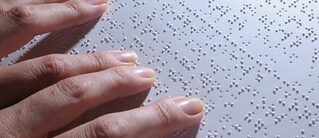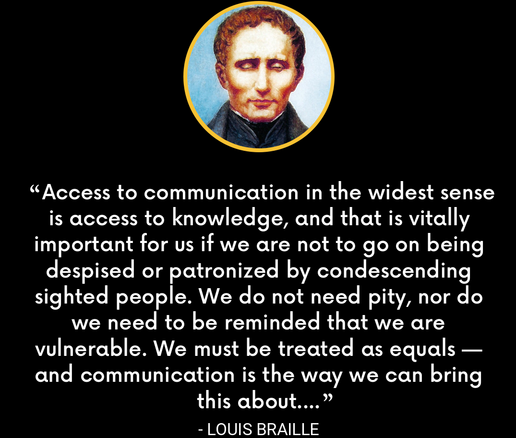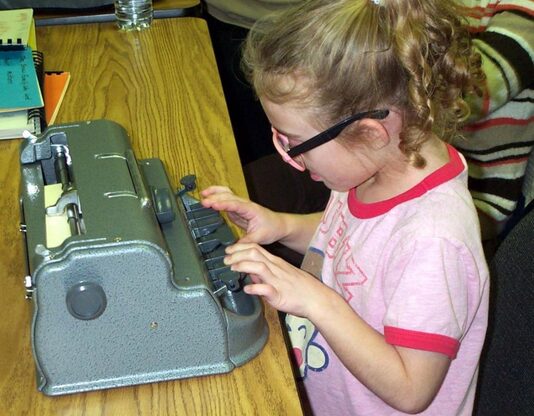 The Braille alphabet is used by people who are blind or partially sighted as a basis of the larger Braille code for reading and writing. Kids and adults who are blind read Braille by gliding their fingertips over the lines of embossed Braille dots. They write braille using a variety of tools, such as the Perkins Brailler.
The Braille alphabet is used by people who are blind or partially sighted as a basis of the larger Braille code for reading and writing. Kids and adults who are blind read Braille by gliding their fingertips over the lines of embossed Braille dots. They write braille using a variety of tools, such as the Perkins Brailler.
I do not own a Perkins Brailler, so I use a slate and stylus to write my labels.
People who are sighted can learn Braille as well, either by touch or using their vision. People who have dyslexia or other disabilities that affect what they are looking at and what their brain is interpreting can also benefit from reading by touch.
A proficient Braille reader a person can read between 170 and 220 words a minute. A great place for everyone to begin learning Braille is with the Braille alphabet.
LEARN HOW TO READ BRAILLE
The first thing to know is that Braille is a code and not a language itself. There are different “grades” and versions of Braille. The most basic is “grade one Braille”. Every letter is transcribed. For every letter in the English alphabet, there is a Braille character. And each Braille letter is made of a combination of raised dots in the Braille cell. A Braille cell is the basic component of Braille.

A BRAILLE CELL

A Braille cell is comprised of raised dots arranged in two columns and 3 rows. Each dot has a number from 1-6. The top left corner of the cell is dot 1. Moving down the column to the middle row is dot 2 and in the bottom left corner is dot 3. In the top right corner is dot 4, the middle dot in the right column is dot 5. The bottom right corner is dot 6. A full Braille cell is all 6 dots.
This symbol is used on Canadian dollar bills. To learn more about Canadas accessible cash read my currency blog

Braille letters A-J

The Braille alphabet uses a pattern throughout the alphabet. The easiest letter to learn is “a” which is dot 1. Next, the letter “b” is dot 1 and dot 2, and “c” is dot 1 and dot 4. Here is a photo of the dot configurations.
|
a |
1 |
|
b |
1,2 |
|
c |
1,4 |
|
d |
1,4,5 |
|
e |
1,5 |
|
f |
1,2,5 |
|
g |
1,2,4,5 |
|
h |
1,2,5 |
|
i |
2,4 |
|
j |
2,4,5 |
Braille letters K-T

The second set of letters follows the pattern only adding a dot 3 to each character in the first set of Braille letters.
|
k |
1,3 |
|
l |
1,2,3 |
|
m |
1,3,4 |
|
n |
1,3,4,5 |
|
o |
1,3,5 |
|
p |
1,2,3,4 |
|
q |
1,2,3,4,5 |
|
r |
1,2,3,5 |
|
s |
2,3,4 |
|
t |
2,3,4,5 |
Braille letters U-Z

The last set of letters continues the pattern by adding a dot 6 to the second set of letters. However, there is one exception that interrupts the pattern here. At the time Louis Braille invented the first version of the Braille alphabet, the French language did not use the letter “w” so it is skipped. The Braille letter “w” is instead created by dots 2, 4, 5, 6.
|
u |
1,3,6 |
|
v |
1,2,3,6 |
|
w |
2,4,5,6 |
|
x |
1,3,4,6 |
|
y |
1,3,4,5,6 |
|
z |
1,3,5,6 |
Lower-case vs Upper-case
These are all of the lower-case Braille letters in the English alphabet. To form a capital letter, you must place a dot 6 before the letter. There are also Braille characters for other punctuation and symbols. If all letters are capitalized, then two dot 6 will be before the word.
OTHER WAYS TO USE BRAILLE
Now, you’re probably wondering about Braille numbers, Braille music and even other languages in Braille. Braille numbers are like letters but have a special number sign character in front to tell readers that the characters that follow are intended to be numbers. There are also special codes for math, and Braille music notation.
A brief history of Braille

Louis Braille invented the Braille system in 1824 at the age of 15 and continued to improve upon it throughout his lifetime. We continue to make updates to Braille today. In 2016, the United States switched to the Unified English Braille code (UEB) from the American version of Braille.
Louis Braille’s birthday is on January 4th, and on that day we celebrate World Braille Day. This is to raise awareness of the importance of Braille literacy.
Just imagine if everyone learned about Braille and used it wherever there is print! There’d be more access to the world for the people who read Braille and more opportunities for others to learn. Books, museums, stores, offices… Braille is yet to be included everywhere we need it.
Together, we can make the world more inclusive for Braille readers.



Comments
There are currently no blog comments.